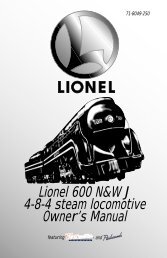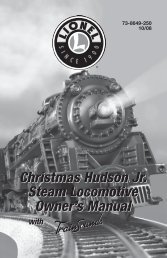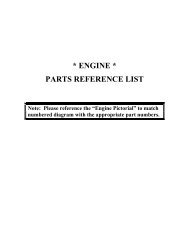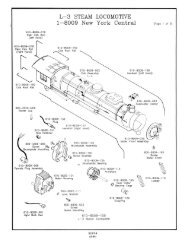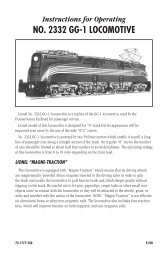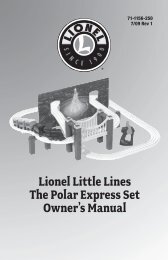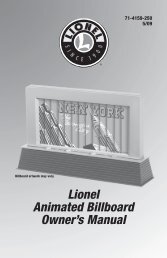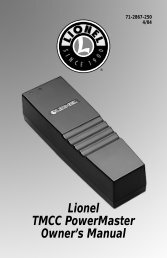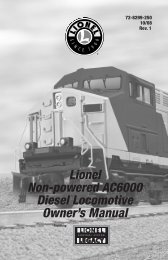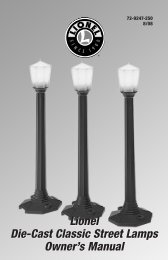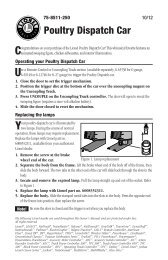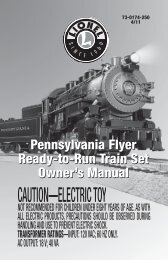GP-7 Diesel Locomotive - Lionel
GP-7 Diesel Locomotive - Lionel
GP-7 Diesel Locomotive - Lionel
You also want an ePaper? Increase the reach of your titles
YUMPU automatically turns print PDFs into web optimized ePapers that Google loves.
72-8561-250<br />
8/08<br />
<strong>Lionel</strong><br />
<strong>GP</strong>-7 <strong>Diesel</strong> <strong>Locomotive</strong><br />
Owner’s Manual<br />
Featuring
Congratulations!<br />
Congratulations on your purchase of the <strong>Lionel</strong> <strong>GP</strong>7 <strong>Diesel</strong> <strong>Locomotive</strong>! On the outside, this<br />
locomotive features numerous prototypical details and expert decoration in your favorite<br />
livery. Inside the body, this locomotive is equipped with some of the most advanced sounds and<br />
controls in model railroading. The <strong>GP</strong>7 is ready for duty on your layout.<br />
Features of the locomotive<br />
• LEGACY Control System equipped—able to run with the new LEGACY<br />
Control system, in the TrainMaster Command Control environment, or in<br />
the conventional environment with only a standard transformer<br />
• LEGACY RailSounds sound system with intelligible CrewTalk dialog and<br />
TowerCom announcements, each with different scenarios depending on<br />
whether the locomotive is in motion or stopped<br />
• Odyssey II Speed Control with ON/OFF switch<br />
• Directional lighting including operating LED headlights<br />
• Two ElectroCouplers<br />
• Dual powerful maintenance-free motors with momentum flywheels<br />
• Four traction tires<br />
• Fan-driven smoke unit<br />
• Directional bi-color market lights<br />
• Lighted number boards<br />
• Lighted cab interior<br />
• Minimum curve: O-31<br />
The following <strong>Lionel</strong> marks may be used throughout this instruction manual and are protected under law. All<br />
rights reserved.<br />
<strong>Lionel</strong> ® , TrainMaster ® , Odyssey ® , RailSounds ® , CrewTalk , TowerCom , DynaChuff , StationSounds ,<br />
Pullmor ® , ElectroCoupler , Magne-Traction ® , CAB-1 ® Remote Controller, PowerMaster ® , <strong>Lionel</strong> ZW ® , ZW ® ,<br />
PowerHouse ® , TMCC ® , <strong>Lionel</strong>ville, Lockon ® , Wireless Tether , LionMaster ® , FatBoy , American Flyer ® ,<br />
TrainSounds , PowerMax , LEGACY , PowerMax Plus, Odyssey II , LEGACY RailSounds <br />
The name FasTrack ® is used with permission from Pitsco, Inc.
Table of contents<br />
Quick Start<br />
LEGACY Control operations 4<br />
TrainMaster Command Control operations 4<br />
Transformer operations 4<br />
LEGACY Control Systems operations–overview<br />
Get ready to run 5<br />
Start ‘Er Up 5<br />
The LEGACY CAB-2 Remote Controller 6<br />
The velocity throttle 7<br />
The multi-controller 7-8<br />
The train brake slider 8<br />
The warning sound controller 9<br />
The speed bar 10<br />
<strong>Locomotive</strong> switch function overview<br />
Switch overview 11<br />
TrainMaster Command Control operations<br />
TrainMaster Command Control operations 12<br />
Operating your locomotive in the Command Control environment 12<br />
CAB-1 Remote Controller commands 13<br />
CAB-1 Remote Controller numeric keypad commands 14<br />
CAB-1 numeric keypad table 15<br />
Tuning your locomotive’s performance 16-17<br />
Assigning your locomotive a new ID# 18<br />
Building a lash-up 19<br />
Reprogramming your locomotive to restore features 20<br />
Conventional transformer operations<br />
Operating your locomotive in the conventional environment 21-22<br />
Locking your locomotive into a single direction 23<br />
Uncoupling in the conventional environment 23<br />
Odyssey II Speed Control system operations<br />
Odyssey II Speed Control system operations 24<br />
Odyssey II Speed Control system LEGACY Control operation 24<br />
Odyssey II Speed Control system TrainMaster Command Control operation 24<br />
Odyssey II Speed Control system conventional transformer operation 24<br />
LEGACY RailSounds sound system operations<br />
LEGACY RailSounds sound system operations 25<br />
Installing the battery 26<br />
Using the LEGACY RailSounds sound system in the conventional environment 27<br />
Installing a <strong>Lionel</strong> Sound Activation Button for conventional operation 28<br />
Activating the CrewTalk dialog and TowerCom announcements<br />
in the conventional environment 29<br />
Using the LEGACY RailSounds sound system in the TrainMaster Command Control environment 30<br />
Activating the CrewTalk dialog and TowerCom announcements<br />
in the Command Control environment 31<br />
LEGACY RailSounds on a round trip 32<br />
Maintaining and servicing your locomotive<br />
Lubricating your locomotive 33<br />
Adding fluid to your locomotive’s smoke generator 34<br />
Adjusting the smoke output 35<br />
Replacing your locomotive’s LEDs and lamps 35<br />
Replacing the traction tires 35<br />
Limited Warranty/<strong>Lionel</strong> Service 36
Quick Start<br />
Note!<br />
Power your locomotive with an alternating-current (AC) transformer only. Powering<br />
your locomotive with a direct-current (DC) transformer, or in excess of 19 volts AC, may<br />
result in damage to sensitive electronic components.<br />
LEGACY Control operations<br />
For the finest operating experience, your <strong>GP</strong>-7 locomotive is fully compatible with the new<br />
LEGACY Control System.<br />
To operate in LEGACY mode, you need a LEGACY Command Base and LEGACY CAB-2 Remote<br />
Controller. Both products are offered together in the LEGACY Command Set, 6-14295.<br />
1. Turn off track power and plug in the LEGACY Base.<br />
2. Place your locomotive on <strong>Lionel</strong> or <strong>Lionel</strong>-compatible O-31 or larger track.<br />
3. Increase track power voltage to full power (no more than 19 volts AC).<br />
4. Press ENG and 1 to address your locomotive with your LEGACY CAB-2 Remote<br />
Controller.<br />
5. Throttle up and move ‘em out.<br />
TrainMaster Command Control operations<br />
To operate your locomotive in the Command Control environment, you need a Command Base<br />
(available separately, 6-12911) and a CAB-1 Remote Controller (available separately, 6-12868).<br />
1. Turn off track power and plug-in the Command Base.<br />
2. Place your locomotive on <strong>Lionel</strong> or <strong>Lionel</strong>-compatible O-31 or larger track.<br />
3. Increase track voltage to full power (no more than 19 volts AC).<br />
4. Press ENG and 1 to address your locomotive with your CAB-1 Remote<br />
Controller.<br />
5. Throttle up and move ‘em out.<br />
Transformer operations<br />
1. Place your locomotive on <strong>Lionel</strong> or <strong>Lionel</strong>-compatible O-31 or larger track.<br />
2. Power your locomotive at 12-18 volts with your alternating current (AC)<br />
transformer.<br />
3. Wait three to eight seconds until the locomotive’s headlight illuminates and<br />
the LEGACY RailSounds sound system starts up.<br />
4. Move ‘em out! Press the DIRECTION button on your controller, then throttle<br />
up.
LEGACY Control System operations–overview<br />
Please note that not all LEGACY products have all the features<br />
mentioned in this section.<br />
Note!<br />
This section is a brief overview of the LEGACY Control System. For a more in<br />
depth explanation of the LEGACY Control System features, please see your LEGACY<br />
Control System Operations Manual.<br />
GET READY TO RUN<br />
Get your engine running now by following the instructions in this guide. We'll power up the track,<br />
"address the engine" so it can be controlled by your CAB-2 remote and learn to use the Velocity<br />
Throttle, Whistle, Bell, Brake and Direction commands.<br />
Power Up The Track<br />
Refer to PowerMaster, TPC, or ZW manual for the correct method to power up. With your<br />
locomotive on the track and ready to roll, power-up your track to a constant 18 volts. If a circuit<br />
breaker trips when you turn on the <strong>Lionel</strong> power supply, check the wheels of your locomotive to make<br />
sure they are all securely on the track. Check to make sure the track is free of all metals that may<br />
cause a short circuit.<br />
Address Your Engine<br />
First, you must address the engine. This "tells" your CAB-2 which locomotive you want to control.<br />
This is important when you have more than one engine on your layout.<br />
To address an engine:<br />
1. Press ENG<br />
2. Press 1<br />
3. Press Start Up<br />
See reference numbers 1, 2, and 3<br />
Start 'Er Up<br />
Now it is time to start up your engine's sound system.<br />
To start the engine's Railsounds system, press Start on the touch-screen or any action key<br />
(Whistle, Bell, Velocity Throttle, etc.).<br />
Your engine sound system will start up and the Touch-screen Control Panel will appear.
LEGACY Control System operations–overview<br />
The LEGACY CAB-2 Remote Controller<br />
Main Display<br />
Displays real-time information about your railroad<br />
system. Displays real-time feedback of operation.<br />
Scroll Button<br />
Navigates through the entire list<br />
of Engines, Trains, Switches, etc.<br />
Select Button<br />
Performs addressing by<br />
3-4 digit road number.<br />
Touch Screen Key Pad<br />
A group of touch sensitive keys<br />
with icons for each function. These<br />
keys serve many purposes and<br />
their icons change accordingly.<br />
Train Brake Slider<br />
This slider is used to increase<br />
or decrease the amount of Train<br />
Brake effecting the engine or train.<br />
Train Link Button<br />
For future use.<br />
AUX-1/Thru Button<br />
Press to view the Control Panel<br />
while operating. Controls switch<br />
direction.<br />
AUX-2/Out Button<br />
Controls switch direction.<br />
Emergency Halt Button<br />
Stops everything on<br />
layout, also stops<br />
recording playback.<br />
Record Button<br />
Used to record and<br />
playback events.<br />
Velocity Throttle<br />
Throttle control over<br />
engines, also used<br />
to navigate thru info/<br />
options.<br />
Set Button<br />
Used to set Engine address and for<br />
programming.<br />
Info Button<br />
Used to enter/view the info/options of<br />
selected components.<br />
CTC Button<br />
Turns the Remote Control ON and<br />
OFF. Used to enter the Remote and<br />
Base options. Pressing CTC while<br />
in a menu will always bring you<br />
back to main screen.<br />
Soft Keys<br />
These keys directly correlate to the<br />
5 selection boxes located at the<br />
bottom of the main screen. These<br />
are also used in the info/option<br />
menus to select options.<br />
Warning Sound Controller<br />
Warning Bell and Variable Whistle/<br />
Horn control. Pull down to sound<br />
Whistle/Horn. Push up and release<br />
to trigger Warning Bell.<br />
Official R.R. Speed Control Bar<br />
Toggles the touchscreen display of R.R.<br />
preset speeds and control panel.<br />
Multi Controller<br />
Boost, Brake, and Direction control.<br />
Rock forward for Boost, rock<br />
backward for engine brake, and<br />
press down for direction change.<br />
Click-hold-and rock for absolute<br />
direction select.<br />
Front & Rear Coupler Buttons<br />
Fire couplers.<br />
Feedback Buttons<br />
Toggle ON/OFF the vibration feedback<br />
feature in the CAB-2 Remote.<br />
Low, Medium, High Momentum Buttons<br />
Used to select the desired momentum of<br />
your addressed engine/train/accessory.
LEGACY Control System operations–overview<br />
THE VELOCITY THROTTLE<br />
The Velocity Throttle (that big red rotary knob in the middle of your <strong>Lionel</strong> remote) is<br />
used to start your engine moving, slow it down or speed it up. Use it simply by turning it<br />
clockwise (speed up) or counter-clockwise (slow down).<br />
4. Turn the Velocity Throttle clockwise a small amount. Your engine will begin to move.<br />
5. Experiment with the engine’s response to the Velocity Throttle. Turn the Velocity Throttle<br />
clock-wise and counter-clock-wise.<br />
6. Slow and stop your engine by turning the Velocity Throttle counter-clockwise.<br />
See reference numbers 4, 5, and 6<br />
THE MULTI-CONTROLLER<br />
Direction<br />
The direction of your engine toggles between forward and reverse at the touch of the Multi-<br />
Controller.<br />
7. Press the Multi-Controller once. Your engine's lights will change directions.<br />
8. Turn the Velocity Throttle clockwise a small amount. Your Engine will reverse directions<br />
and travel in the opposite direction.<br />
See reference numbers 7, and 8
LEGACY Control System operations–overview<br />
THE MULTI-CONTROLLER (continued)<br />
Boost & Brake<br />
Boost and brake give you another way to<br />
control the speed of your train. Boost gives your<br />
loco a temporary increase in tractive power, and<br />
returns to the previous speed when you release the<br />
control, while the brake command slows you down<br />
quicker than the Velocity Throttle alone and holds<br />
your speed at the adjusted level.<br />
9. Experiment with Boost and Brake. Notice how<br />
your engine responds to the Multi-Controller. See reference number 9<br />
THE TRAIN BRAKE SLIDER<br />
Train Brake is used to slow down and limit the top speed of your train by adding a load.<br />
A The more the Train Brake is applied by pulling the Train Brake Slider down, the more<br />
laboring is heard from the engine. Eventually Train Brake application will slow down the train<br />
and it is even possible to stop a train by pulling the Train Brake Slider all the way down. A<br />
tremendous amount of laboring can be heard whenever you apply the Train Brake in a large<br />
amount.<br />
10. Experiment with the Train Brake. Try a small amount of the Train Brake when your<br />
engine is moving down the rails at a medium speed. Notice the effect the Train Brake has<br />
on sound and speed. Try adding more Train brake and notice that the Train Brake can<br />
limit the top speed available to your engine.<br />
Try adding even more Train Brake and notice that the Engine sounds like it is working<br />
harder and harder as the Train Brake is applied more.<br />
See reference number 10
LEGACY Control System operations–overview<br />
THE WARNING SOUND CONTROLLER<br />
Warning sounds are an important part of <strong>Lionel</strong> Railroading. Your <strong>Lionel</strong> Legacy Control<br />
System equipped engines have a real-time variable "quilling" whistle and horn, while<br />
<strong>Lionel</strong> TMCC engines do not have this feature.<br />
11. Blow the Horn/Whistle by pulling down on the Warning Sound Controller.<br />
12. Try pulling down the Warning Sound Controller various amounts and listen. Notice the<br />
difference in intensity of the Whistle or Horn.<br />
13. Push the Warning Sound Controller up once and quickly release. Notice that the bell rings<br />
once.<br />
14. Push the Warning Sound Controller up and hold it for 1.5 seconds. Notice that the Bell is<br />
sounding continuously.<br />
15. Push the Warning Sound Controller up once. Notice that the continuous Bell stops.<br />
16. Experiment with ringing the Bell in your own rhythm or continuously, depending on how<br />
you push the Warning Sound Controller<br />
See reference numbers 11, and 12 See reference numbers 13, 14, 15, and 16
LEGACY Control System operations–overview<br />
THE SPEED BAR<br />
Selection of Official Rail Road Speeds<br />
The Speed Bar is used to select a new touch-screen Icon Control set. This set of touchscreen<br />
keys is used to select official Railroad Speeds. Two additional controls, "High Ball,"<br />
(Top Speed) and "Brake to Roll," (speed step one) are possible with this Touch-Screen set of<br />
controls. Pressing AUX-1 returns you to the standard control panel.<br />
17. Press, hold and release the<br />
RR Speed icons one by one.<br />
Experiment.<br />
18. The speed of the engine<br />
changes with each press and<br />
release of a different RR<br />
Speed key.<br />
19. TowerCom dialog occurs each<br />
time you press and hold a RR<br />
speed key.<br />
20. The Engineer dialog<br />
responds and the speed of the<br />
engine changes as soon as<br />
you release the RR speed key.<br />
21. If you touch a RR speed<br />
key and release it quickly, a<br />
speed change is enabled with<br />
no dialog scene.<br />
22. You can also use the Velocity<br />
Throttle and other action<br />
controls in this mode and<br />
continue to use Official RR<br />
See reference numbers 17, 18, 19, 20, 21, 22, 23, 24, and 25<br />
speeds at the same time.<br />
23. Repeat step 17.<br />
24. Press AUX-1 to leave the RR speed mode and return to the standard mode and return to<br />
the standard control panel.<br />
25. Press the speed bar to toggle between the Official RR Speed Control Panel and the<br />
Standard Control Panel.<br />
At this point you know the basics of how to operate. There is a lot of fun waiting as you<br />
experience the interaction of the controls and the touch-screen.<br />
Be sure to read the entire <strong>Lionel</strong> Legacy Control System Manual to get the most from your<br />
<strong>Lionel</strong> products.<br />
10
<strong>Locomotive</strong> switch function overview<br />
Switch overview<br />
Command Reverse Unit Switch<br />
Used to assign an ID# and reprogram the locomotive in LEGACY and Command operation<br />
when the switch is in the “PGM” position. Also used to “lock” your locomotive in a single<br />
direction, or neutral, in conventional operation when the switch is placed in the “PGM”<br />
position. See pages 18, 19, 20, and 23.<br />
Smoke Unit Switch<br />
Used to turn the smoke unit function “on” and “off”. See page 34.<br />
LEGACY RailSounds Sound System Switch<br />
Used to select RailSounds (RS) or SignalSounds (SS). In the RailSounds position, all sounds<br />
are provided. In the SignalSounds position, only the Horn and Bell are heard. See page 27.<br />
Odyssey II Speed Control System Switch<br />
Used to turn the Odyssey II Speed Control System “on” and “off”. See pages 22, and 24.<br />
Command reverse unit<br />
switch<br />
FRONT<br />
Odyssey II Speed Control<br />
System switch<br />
ODY NO ODY<br />
RUN PGM<br />
RS SS<br />
SMK NO SMK<br />
Smoke unit switch<br />
LEGACY RailSounds sound<br />
system switch<br />
Figure 1. Switch locations<br />
11
TrainMaster Command Control operations<br />
TrainMaster Command Control operations<br />
In addition to your transformer, to operate your locomotive in the Command Control<br />
environment, you need a Command Base (available separately, 6-12911) and a CAB-1<br />
Remote Controller (available separately, 6-12868).<br />
Your commands are sent by the CAB-1 Remote Controller to the Command Base, which<br />
then translates the command into digital code. That code is sent through the outside rails<br />
to your locomotive, which will not respond until it recognizes its unique ID#. TrainMaster<br />
Command Control gives you the power to operate multiple Command-equipped locomotives<br />
on the same track at the same time.<br />
Keep in mind that track power is like gasoline in the tank of a car—it gives you the power<br />
to go places, but it doesn’t tell you where to go or how fast to get there.<br />
Operating your locomotive in the Command Control environment<br />
1. Turn off track power and plug-in the Command Base. Be sure that the<br />
Command Base is connected to the outside rail or to the Common/Ground/U terminal on<br />
your track power supply.<br />
2. Place your locomotive on <strong>Lionel</strong> or <strong>Lionel</strong>-compatible O-31 or larger<br />
track.<br />
3. Increase track voltage to full power (no more than 19 volts AC). On<br />
PowerMasters, slide the CMD/CONV switch to CMD. Program Track Power Controllers to<br />
Command Control operation.<br />
Caution!<br />
Power your locomotive with an alternating-current (AC) transformer only.<br />
Powering your locomotive with a direct-current (DC) transformer, or in excess of<br />
19 volts AC, may result in damage to sensitive electronic components.<br />
4. Press ENG and enter the ID# to address your locomotive with your CAB-1<br />
Remote Controller. All <strong>Lionel</strong> locomotives come factory-programmed as ID# 1. To<br />
change the ID#, see page 18.<br />
5. Throttle up and move ‘em out! Your locomotive will respond to every command from<br />
your CAB-1 Remote Controller.<br />
12
TrainMaster Command Control operations<br />
CAB-1 Remote Controller commands<br />
The CAB-1 Remote Controller commands are detailed below. The corresponding<br />
RailSounds sound system effects are in bold italic type.<br />
Releases the front coupler.<br />
Coupler release sound.<br />
Releases the rear coupler.<br />
Coupler release sound.<br />
Activates the numeric keypad.<br />
Air release sound.<br />
Toggles all directional lighting on and off.<br />
Toggles the interior cab light on<br />
and off when the locomotive is<br />
either stopped or in motion.<br />
Accelerates the locomotive with a clockwise<br />
rotation. Decelerates the locomotive with a<br />
counter-clockwise rotation.<br />
Shuts down all PowerMasters on your railroad.<br />
Stops all TrainMaster Command Controlequipped<br />
locomotives in operation. Use HALT<br />
only in emergency situations.<br />
Activates the locomotive’s horn. Release the<br />
button to discontinue the sound. Multihorn<br />
diesel horn sound.<br />
Toggles the bell sound on and off.<br />
Mechanical bell sound.<br />
Changes the locomotive’s direction. The locomotive<br />
decelerates to a stop and continues in the opposite<br />
direction when you increase the throttle. Air release<br />
sound.<br />
Increases the locomotive’s speed while the button is<br />
pressed. Release the button to return to the initial speed.<br />
Decreases the locomotive’s speed while the button<br />
is pressed. Squealing brake sounds.<br />
13<br />
SET L M H<br />
L = 32 speed steps<br />
M = 100 speed steps<br />
H = 100 speed steps<br />
with momentum.
TrainMaster Command Control operations<br />
CAB-1 Remote Controller numeric keypad commands<br />
When you press the AUX1 button on your CAB-1 Remote<br />
Controller, you turn the numeric keypad into ten command<br />
buttons. These commands are specific to your locomotive, and an<br />
overlay is included to help you learn these functions. After you press<br />
the AUX1 button, you will be able to press any numbered button until<br />
you address a different Command Control equipped product. The<br />
corresponding LEGACY RailSounds sound system effects<br />
are in bold italic type.<br />
Stops and resets the locomotive. Resets the locomotive’s direction to<br />
forward. Horn blows. RPM sounds return to automatic.<br />
Raises the volume of the LEGACY RailSounds sound system background sounds, such as RPM<br />
sounds and let-off sounds. The horn, bell and dialog are unaffected. The default is full volume.<br />
The volume setting is retained when track power is turned off. Sound volume increases.<br />
Engineer begins radio dialog, dispatcher replies (see pages 31 and 32). CrewTalk<br />
communication.<br />
Enters manual RPM mode and increases the RailSounds sound system RPM level (see<br />
page 16). If the LEGACY RailSounds sound system is shut down (see 5 key below), AUX1, 3<br />
activates a full LEGACY RailSounds sound system start-up while the locomotive is stopped after<br />
pressing AUX1, 5 with track power on.<br />
Lowers the volume of the LEGACY RailSounds sound system background sounds, such as RPM<br />
sounds and let-off sounds. The horn, bell, and dialog are unaffected. The volume setting is<br />
retained when track power is turned off. Sound volume decreases.<br />
Activates the LEGACY RailSounds sound system shutdown sequence when stopped. Activates the<br />
emergency stop feature while in motion. Note that in the shutdown sequence, the smoke unit<br />
does not turn off if it was already on. To turn off the smoke unit, press AUX1, 8 or use the<br />
smoke unit SMK/NO SMK switch.<br />
Enters manual RPM mode and lowers the LEGACY RailSounds diesel motor RPM level (see<br />
page 16).<br />
Dispatcher begins radio dialog, engineer replies (see pages 31 and 32). TowerCom<br />
announcement.<br />
Turns off the smoke unit. Air release sound.<br />
Turns on the smoke unit if the smoke unit switch is in the SMK position. Be sure to add smoke<br />
fluid before turning on the smoke unit to prevent damage to your locomotive. Steam<br />
generator blow-off sound.<br />
Note!<br />
AUX1, 8 and 9 function only if the locomotive’s smoke unit switch is in the SMK<br />
position. Sounds will be active in both switch positions.<br />
14
TrainMaster Command Control operations<br />
CAB-1 numeric keypad table<br />
The 3, 5, and 6 keys on your CAB-1 can perform several different functions when<br />
controlling your locomotive. These functions include:<br />
• Starting up and shutting down the engine sounds.<br />
• Controlling the engine RPM sounds manually ("Manual RPM Mode").<br />
If you press AUX1 immediately before you press the 3, 5 or 6 button, its function will be<br />
modified. The following table summarizes the functions of these CAB-1 Remote Controller<br />
buttons for your locomotive.<br />
Key Command<br />
LEGACY RailSounds sound system<br />
3 If the LEGACY RailSounds sound system is shut down, engine sounds start up.<br />
If the LEGACY RailSounds sound system is running, engine enters manual RPM<br />
mode and revs up RPM one level with each press.<br />
AUX1, 3<br />
(same as above)<br />
5 If locomotive is stopped, engineer announces "shut down," engine sounds turn<br />
off. If the locomotive is moving, the dispatcher instructs, “Go to restricted speed.”<br />
AUX1, 5 If the locomotive is moving, the dispatcher instructs, “Emergency stop!”<br />
6 If the locomotive is moving, engine enters manual RPM mode and revs<br />
down RPM one level with each press.<br />
AUX1, 6 (same as above)<br />
15
TrainMaster Command Control operations<br />
Tuning your locomotive’s performance<br />
TrainMaster Command Control allows you to fine-tune the performance of your locomotive.<br />
Use your CAB-1 Remote Controller to make these adjustments. See page 14.<br />
Note!<br />
These settings will be lost if you assign a new ID#.<br />
RPM RUN LEVEL<br />
Your locomotive has eight levels of RPM sounds, corresponding to the eight run levels in<br />
a real diesel locomotive. The three ways in which you can control your locomotive's RPM<br />
sounds are discussed below.<br />
Automatic RPM Mode<br />
In Automatic RPM Mode, your locomotive's RPM run level is controlled by movements of<br />
the throttle on your CAB-1 Remote Controller. A small clockwise motion of the throttle knob<br />
will cause the RPM sounds to ramp up one run level, while a small counter-clockwise motion<br />
of the throttle knob will cause the RPM sounds to ramp down one run level.<br />
While the locomotive is ramping between run levels, it will ignore additional throttle<br />
movements. Once the RPMs have finished ramping to the next run level, additional throttle<br />
motions will again trigger another RPM ramp. This feature will allow you to "fine-tune" your<br />
RPM run level, regardless of the locomotive's speed, using only the throttle knob. This mode is<br />
the default setting for your locomotive on power up.<br />
Manual RPM Mode<br />
In Manual RPM Mode, you can set your locomotive's RPM run level to a constant value by<br />
pressing the AUX1, 3 or AUX1, 6 key sequences on your CAB-1 Remote Controller. When your<br />
locomotive is in this mode, its RPM run level will not vary with throttle movements or with the<br />
speed of the locomotive.<br />
To enter Manual RPM Mode, press the AUX1, 3 key sequence while the locomotive is<br />
stopped, or press either the AUX1, 3 or AUX1, 6 key sequence while the locomotive is<br />
moving. Pressing AUX1, 3 will cause your locomotive to enter Manual RPM Mode and ramp<br />
up one RPM run level; pressing AUX1, 6 will cause your locomotive to enter Manual RPM<br />
Mode and ramp down one RPM run level. You may then press the 3 or 6 key additional times<br />
to ramp your locomotive's RPMs through all the run levels. Once you set your locomotive's<br />
RPM run level it will remain there until you change it with the 3 or 6 keys, or until you exit<br />
Manual RPM Mode.<br />
You may cause your locomotive to exit Manual RPM Mode in several ways: reset the<br />
locomotive with AUX1, 0 key sequence; enter the shutdown sequence with the AUX1, 5 key<br />
sequence; or turn off the track power and allow the locomotive to reset.<br />
Speed RPM Mode<br />
In Speed RPM Mode, your locomotive's RPM run level is controlled only by the actual<br />
speed of the locomotive.<br />
16
TrainMaster Command Control operations<br />
Tuning your locomotive’s performance (continued)<br />
Speed RPM Mode (continued)<br />
To enter Speed RPM Mode, press the AUX1, BRAKE key sequence while the locomotive<br />
is stopped. A distinctive "clunk" sound will be heard. Once your locomotive is in Speed RPM<br />
Mode, the RPMs will ramp up and down through its eight run levels depending on how fast<br />
the locomotive is moving on the track. (Note that this is how your locomotive's RPMs are<br />
controlled when it is running in Conventional Mode.)<br />
To exit Speed RPM mode, reset the locomotive with AUX1, 0 key sequence or turn off the<br />
track power and allow the locomotive to reset.<br />
Adjusting the speed<br />
The BRAKE and BOOST buttons give you incremental control of your locomotive’s speed<br />
while you press and hold these buttons, allowing you to make small, gradual adjustments<br />
around curves and over grades. The locomotive will resume its initial speed when the buttons<br />
are released. Listen for the squeal of your locomotive’s brakes when you use the BRAKE<br />
button.<br />
Sound LEVEL<br />
Press AUX1, 1 or 4 on your CAB-1 Remote Controller to raise and lower the volume of the<br />
background locomotive sounds, such as RPMs and air release or let-offs. The horn, bell and<br />
dialog will be unaffected. Note that this setting is preserved through power down and system<br />
reset. Remember that the sounds will be silent when you power up your locomotive if the<br />
sounds were turned down previously. To set the maximum volume of both the background and<br />
foreground sounds, we recommend that you adjust your locomotive’s volume control knob<br />
(see Figure 3 on page 26 for the location).<br />
17
TrainMaster Command Control operations<br />
Assigning your locomotive a new ID#<br />
As your roster of TrainMaster Command Control-equipped locomotives grows, you<br />
will want to give each unit a unique ID#. The locomotive will respond to commands<br />
associated with its ID# while all other units will disregard these commands.<br />
Note!<br />
To restore your locomotive’s functions, see page 20.<br />
1. Slide the Command reverse unit switch on your locomotive to the PGM position.<br />
2. Place the locomotive on the track.<br />
3. Connect the Command Base and plug it in.<br />
4. Power up the track.<br />
5. Press ENG.<br />
6. Enter the unique ID#. Choose any number from 1 to 99 that has not been assigned to<br />
another locomotive (ENG). We recommend using a part of your locomotive’s cab number.<br />
7. Press SET. The locomotive’s horn will sound if the RailSounds sound system is on and the<br />
headlights will flash.<br />
8. Slide the Command reverse unit switch back to the RUN position.<br />
The locomotive’s ID# has been set. Be sure to record the new ID# for your reference.<br />
18
TrainMaster Command Control operations<br />
Building a lash-up<br />
TrainMaster Command Control allows you to couple your Command Control-equipped<br />
locomotives together, forming a multiple unit lash-up. Just like with the real railroads, lash-ups<br />
allow you to pull longer trains and climb steeper grades. You will find that the lighting operates<br />
prototypically—the lead unit’s headlight and interior lights are illuminated when the train is in<br />
forward, and the rear unit’s headlight and interior lights are on when the train is in reverse. For<br />
more information, refer to your TrainMaster Command Control manual.<br />
To build a lash-up, assign a unique engine (ENG) ID# to each unit. Arrange the units on the<br />
track and couple them together. The Command reverse unit switch must be set to RUN. See Figure 1<br />
on page 11.<br />
Note!<br />
If you press a wrong button, start over with that particular unit. The assignment isn’t<br />
saved until you press SET.<br />
Start with the lead (front) unit<br />
1. Press TR and enter your lash-up ID# (1-9) on your CAB-1 Remote Controller. No other lash-up<br />
or track should share this ID#.<br />
2. Enter the unique ID# of the lead unit.<br />
3. Press F.<br />
4. Press SET on the CAB-1 Remote Controller.<br />
Add the middle units, one at a time<br />
1. Press TR and enter the lash-up ID# (1-9) on your CAB-1 Remote Controller.<br />
2. Enter the unique ID# of the middle unit.<br />
3. Press the DIRECTION button if the unit is facing rearward.<br />
4. Press SET on the CAB-1 Remote Controller.<br />
5. Repeat these steps for any additional middle units.<br />
Complete the lash-up by adding the rear unit<br />
1. Press TR and enter the lash-up ID# (1-9) on your CAB-1 Remote Controller.<br />
2. Enter the unique ID# of the rear unit.<br />
3. Press R.<br />
4. Press the DIRECTION button if the unit is facing rearward.<br />
5. Press SET on the CAB-1 Remote Controller.<br />
You are now ready to operate your locomotive as a lash-up. Simply press TR and enter the<br />
lash-up ID#, then use your CAB-1 Remote Controller to operate your locomotives. To operate an<br />
individual unit within the lash-up, press ENG and enter the ID# for that particular unit.<br />
19
TrainMaster Command Control operations<br />
Reprogramming your locomotive to restore features<br />
If your locomotive is unresponsive to your commands in the TrainMaster Command Control<br />
environment, we recommend that you follow this procedure to reset your locomotive.<br />
1. Slide the Command reverse unit switch to the PGM position.<br />
2. Plug in and connect your Command Base.<br />
3. Place your locomotive on the track, then power up the track.<br />
4. Press ENG and enter the locomotive’s ID#.<br />
5. Press SET.<br />
6. Press ENG and enter the locomotive’s ID# again.<br />
7. Press AUX1.<br />
8. Enter 2 for this particular locomotive.<br />
9. Turn off track power and wait ten seconds.<br />
10. Slide the Command reverse unit switch back to the RUN position.<br />
At this point, your locomotive has been reset. Restore power to the track and operate the<br />
locomotive as usual. Be sure to use the ID# entered in Step 4.<br />
20
Conventional transformer operations<br />
Operating your locomotive in the conventional environment<br />
Your locomotive is capable of operating in the conventional environment with nothing<br />
more than a standard <strong>Lionel</strong> alternating-current (AC) transformer.<br />
In the conventional environment, your locomotive cycles through a repeating pattern of<br />
operations: forward, neutral, reverse, neutral, and so on. To advance to the next operation,<br />
press the DIRECTION button on your transformer. Alternately, you could use the throttle to<br />
briefly turn off track power so that the locomotive advances to the next operation when power<br />
is restored.<br />
Once you cycle the locomotive into forward or reverse, you control your locomotive’s<br />
speed by varying track voltage with the transformer’s throttle. To increase the speed of the<br />
locomotive, you increase track voltage. To decrease the speed, you decrease track voltage. To<br />
stop the locomotive and to change directions (or to enter neutral), track voltage is turned off<br />
or interrupted.<br />
Use the HORN and BELL buttons on your transformer to activate these features. If your<br />
transformer is not equipped with these controls, separate buttons are available (610-5906-<br />
001). Please refer to page 28 of this manual.<br />
To experience all of your locomotive’s features, we recommend operating in the LEGACY<br />
Command Control environment. With a simple one-wire connection, you can use the CAB-2<br />
Remote Controller to access all of the functions of your locomotive. Refer to pages 5-10 to see<br />
how to operate your locomotive in the LEGACY Command Control environment.<br />
21
Conventional transformer operations<br />
Operating your locomotive in the conventional environment (continued)<br />
1. Place your locomotive on <strong>Lionel</strong> or <strong>Lionel</strong>-compatible O-31 or larger track.<br />
2. Power your locomotive at 12-18 volts with your alternating current (AC)<br />
transformer.<br />
Caution!<br />
Power your locomotive with an alternating-current (AC) transformer only.<br />
Powering your locomotive with a direct-current (DC) transformer, or in excess<br />
of 19 volts AC, may result in damage to sensitive electronic components. 60 HZ<br />
AC is required. Do not power with 50 HZ AC.<br />
3. Wait three to eight seconds as your locomotive determines whether it<br />
is in a conventional environment or a TrainMaster Command Control<br />
environment.<br />
When the locomotive has determined that a TrainMaster Command Base is not connected<br />
to the track, the locomotive’s headlight will illuminate and the LEGACY RailSounds sound<br />
system will start. You are ready for operation in the conventional environment.<br />
4. Move ‘em out!<br />
Press the DIRECTION button on your transformer to sequence your locomotive through<br />
the repeating pattern of operations: forward, neutral, reverse, neutral, and so on. You may<br />
also briefly turn off track power to advance the locomotive to the next operating state.<br />
Adjust the throttle until your locomotive moves at your desired speed.<br />
Note!<br />
When placing your locomotive on your layout for the first time, it will start out in<br />
neutral. Thereafter, it will start in forward after every power interruption lasting five<br />
seconds or longer.<br />
We recommend that you operate your LEGACY diesel locomotive with The<br />
Odyssey II Speed Control System turned on. You may choose to operate your<br />
locomotive without speed control by placing the Odyssey II Speed Control System switch to the<br />
“NO ODY” position. See Figure 1 on page 11.<br />
Use the HORN and BELL buttons on your transformer to activate those features. Refer to<br />
page 28 if your transformer is not equipped with those buttons. Adjust the volume using the<br />
volume control knob located under the roof panel on the short nose end. Refer to Figure 3 on<br />
page 26.<br />
22
Conventional transformer operations<br />
Locking your locomotive into a single direction<br />
When the Command reverse unit switch is in the RUN position, your locomotive sequences<br />
through a repeating pattern of operations: forward, neutral, reverse, neutral, and so on.<br />
To “lock” your locomotive into a single direction (for example, to operate in forward only), you<br />
can deactivate the Command reverse unit’s sequencing function.<br />
1. Use your transformer’s DIRECTION button or interruptions in track power to get your<br />
locomotive moving in the desired direction or into neutral.<br />
2. Slow the locomotive down without stopping (reduce the throttle without turning off track power).<br />
3. Slide the Command reverse unit switch to the PGM position. At this point, the locomotive is<br />
“locked” into your chosen direction. See Figure 1 on page 11 for the location of this switch.<br />
To restore the forward-neutral-reverse sequence, just slide the Command reverse unit switch back<br />
to the RUN position.<br />
Uncoupling your locomotive in the conventional environment<br />
Your locomotive features two ElectroCouplers that are released by remote control at any<br />
point around your layout in the TrainMaster Command Control environment.<br />
In the conventional environment, the ElectroCouplers will not open manually or by using a<br />
Remote-Control Track section. To couple your locomotive in the conventional environment, you<br />
must rely on a piece of rolling stock equipped with a magnetic coupler. Simply release the magnetic<br />
coupler and couple the rolling stock to the locomotive, even if the ElectroCoupler is closed.<br />
Keep in mind that you may still make use of <strong>Lionel</strong> Remote-Control Track sections (6-65530<br />
for O gauge; 6-12746 and 6-65149 for O-27 gauge; and 6-12020 and 6-12054 for FasTrack layouts)<br />
with the magnetic couplers on the rolling stock. Place the trigger disc on the magnetic coupler over<br />
the central coil on the Remote-Control Track section, then press UNCOUPLE on the track section’s<br />
controller. As illustrated in Figure 2, the magnetic field pulls the disc downward, releasing the coupler.<br />
Remote-Control<br />
Track Section<br />
Figure 2. Magnetic coupler operation<br />
23
Odyssey II Speed Control system operations<br />
Odyssey II Speed Control system operations<br />
The Odyssey II Speed Control system is “cruise control” for your locomotive. Once the<br />
speed control is set, your locomotive will maintain a constant speed, no matter what load<br />
is placed on the locomotive or what grades you have on your layout. The Odyssey II Speed<br />
Control system also allows for extremely slow movement that will amaze any scale enthusiast.<br />
Odyssey II Speed Control System LEGACY Control operation<br />
I<br />
n LEGACY Control System CAB-2 mode, Odyssey II Speed Control system provides 0-199<br />
speed steps. For a more in depth explanation of the LEGACY Control System features, please<br />
see your LEGACY Control System operations manual.<br />
Odyssey II Speed Control system TrainMaster Command Control<br />
operation<br />
When Odyssey II Speed Control system is activated, changes in the speed of the locomotive<br />
will correspond to each signal from the Command Base. For example, when you address the<br />
locomotive and slowly turn the throttle knob, the first flash of the red light on the Command Base<br />
corresponds to the first speed step, which is the slowest speed of the locomotive. The locomotive will<br />
maintain that speed until you increase or decrease the throttle.<br />
In TrainMaster Command Control CAB-1 mode, Odyssey II Speed Control System now provides<br />
selectable resolution and momentum. L=32 speed steps, M= 100 speed steps, and H= 100 speed<br />
steps with momentum. See page 13.<br />
Odyssey II Speed Control system conventional transformer<br />
operation<br />
The Odyssey II Speed Control system is automatically operational when you operate your<br />
locomotive in conventional (non-Command Control) mode, as long as the Odyssey II<br />
Speed Control system switch is in the ODY position (see Figure 1 on page 11). This means that<br />
your locomotive will maintain a constant speed, compensating for grades, loads, and turns.<br />
Simply use your transformer’s throttle to adjust the speed of your locomotive.<br />
Caution!<br />
Note!<br />
In conventional operation, the lights in the locomotive are connected directly to<br />
track power. Do not exceed 14-16 volts for extended periods. Doing so will reduce<br />
the life of your lamps.<br />
Because of the way that speed control operates in conventional mode, you will<br />
notice a slight delay between adjusting your transformer throttle and the change<br />
in the speed of your locomotive. If you desire instantaneous response to throttle<br />
changes, turn off the Odyssey II Speed Control system using the Odyssey switch on<br />
the bottom of the locomotive.<br />
24
LEGACY RailSounds sound system operations<br />
LEGACY RailSounds sound system operations<br />
Y<br />
our locomotive is equipped with the <strong>Lionel</strong> LEGACY RailSounds sound system, the most<br />
realistic model railroad sound system in the world. The LEGACY RailSounds sound system<br />
brings the sounds of the railroad to your layout through high quality sound recordings of real<br />
locomotives.<br />
When you operate your locomotive in the conventional environment, you get the realistic<br />
sounds of the diesel motor, which automatically revs up as the speed of the locomotive<br />
increases. You can sound the locomotive’s horn or activate the ringing of the mechanical bell.<br />
CrewTalk dialog and TowerCom announcements are triggered with the horn button on your<br />
controller. When you are through with operations and power down the track, your locomotive’s<br />
LEGACY RailSounds sound system starts a realistic shutdown sequence (a nine-volt alkaline<br />
battery is required, see Figure 3 on page 26).<br />
When you operate your locomotive in the TrainMaster Command Control environment,<br />
you get full control of the LEGACY RailSounds sound system. In addition to the horn and bell<br />
sounds, the locomotive’s RPM sounds automatically rev up, and you can also set a particular<br />
RPM level using your CAB-1 Remote Controller. In the Command Control environment, the<br />
release of the ElectroCouplers is accompanied by a coupler release sound. Use the BRAKE<br />
button, and listen for the sound of squealing brakes. You can also trigger CrewTalk dialog<br />
and TowerCom announcements, which simulate the interaction between the locomotive crew<br />
and the dispatcher. Whenever you choose to shutdown your locomotive, the realistic shutdown<br />
sequence commences. A nine-volt alkaline battery is required for the shudown sequence, if<br />
track power is turned off. Refer to Figure 3 on page 26.<br />
Operating your locomotive with the LEGACY Control system provides you control of all the<br />
features mentioned above as well as access to the new quilling horn and single hit bell<br />
sounds.<br />
25
LEGACY RailSounds sound system operations<br />
Installing the battery<br />
While the LEGACY RailSounds sound system is powered through the track, we recommend<br />
that you install a nine-volt alkaline battery to prevent the sound system from shutting<br />
down during track power interruptions (for example, at a switch or a dirty section of track).<br />
Follow these steps and refer to Figure 3 as you install the battery.<br />
Note!<br />
If the LEGACY RailSounds sound system turns off during interruptions in track<br />
power, you may need to replace the battery.<br />
1. Lift up and remove the roof panel on the short nose end.<br />
2. Remove the protective cover from the battery harness.<br />
3. Snap the battery harness onto the nine-volt alkaline battery’s terminals.<br />
4. Slide the battery into the battery clip.<br />
5. Replace the roof panel.<br />
Battery<br />
harness<br />
Roof panel<br />
Nine-volt<br />
alkaline<br />
battery<br />
Battery<br />
clip<br />
Volume control<br />
knob<br />
Figure 3. Battery installation and volume control knob location<br />
26
LEGACY RailSounds sound system operations<br />
Using the LEGACY RailSounds sound system in the conventional<br />
environment<br />
When you first power up your locomotive, you will hear the sounds of the locomotive<br />
at rest. As the locomotive set moves, the RPM sounds automatically increase with the<br />
locomotive’s speed. In the conventional environment, the horn and bell sounds are activated<br />
by your transformer controls.<br />
To silence the motor sounds, slide the LEGACY RailSounds sound system switch located on the<br />
underside of the locomotive to the SS (SignalSounds) position (see Figure 1 on page 11 for the location<br />
of this switch) before you power up the locomotive or after the locomotive has been powered down for<br />
a minimum of ten seconds. The horn and bell sounds will still be active. To adjust the volume, use the<br />
volume control knob located under the roof panel on the short nose end. Refer to Figure 3 on page 26.<br />
Note!<br />
Note!<br />
When the LEGACY RailSounds sounds system switch is in the SS position, the<br />
CrewTalk dialog and TowerCom announcements are inactive.<br />
For proper operation of the LEGACY RailSounds sound system during track power<br />
interruptions and for the locomotive shutdown sequence, you must install a ninevolt<br />
alkaline battery. Refer to Figure 3 on page 26.<br />
In the conventional environment, you will experience several features of the LEGACY<br />
RailSounds sound system.<br />
• Eight levels of diesel motor RPM. The level of diesel motor RPM automatically<br />
varies with your throttle adjustments.<br />
• MultiHorn. A different horn sound at different speeds—a LEGACY RailSounds sound<br />
system exclusive.<br />
• Mechanical bell. Press BELL on your transformer to begin the effect, then press BELL a<br />
second time to discontinue the effect.<br />
• CrewTalk dialog and TowerCom announcements. CrewTalk dialog is triggered by<br />
your transformer’s HORN button. See page 29.<br />
• Reverse unit reset sound. Power down your track, wait three seconds, and listen for<br />
the air-release sound—that’s the locomotive telling you that its <strong>Lionel</strong> Command reverse<br />
unit has reset to forward. Because the track is powered down, a nine-volt alkaline battery is<br />
required for this feature. Refer to Figure 3 on page 26.<br />
• Shutdown sequence. When you turn off track power, you have two seconds to power up<br />
again after you hear the reverse unit reset sound. If you do not restore power, you will hear<br />
the realistic diesel shutdown sequence. Because track power is off, a nine-volt battery is<br />
required for this sequence to function. Refer to Figure 3 on page 26.<br />
27
LEGACY RailSounds sound system operations<br />
Installing a <strong>Lionel</strong> Sound Activation Button for conventional operation<br />
If your transformer lacks HORN and BELL buttons, you will need to install <strong>Lionel</strong><br />
no. 610-5906-001 Sound Activation Buttons (available separately) to activate the<br />
locomotive’s horn and bell sounds.<br />
Connect the buttons as shown below. Be sure that all track power passes through the Sound<br />
Activation Button(s). Do not bypass the buttons.<br />
For AC transformers lacking a bell button<br />
Black wire<br />
1 2<br />
Existing wire<br />
Red wire<br />
Common/Ground/U<br />
POWER<br />
SUPPLY<br />
Power/A<br />
<strong>Lionel</strong> no. 610-5906-001<br />
Sound Activation Button for<br />
activating the bell<br />
For AC transformers lacking bell and horn/whistle buttons<br />
<strong>Lionel</strong> no. 610-5906-001<br />
Sound Activation Button<br />
for activating the<br />
horn<br />
Red wire<br />
Black wire<br />
Existing wire<br />
Wire<br />
nut<br />
Red wire<br />
Common/Ground/U<br />
Black wire<br />
POWER<br />
SUPPLY<br />
Power/A<br />
<strong>Lionel</strong> no. 610-5906-001<br />
Sound Activation Button for<br />
activating the bell<br />
28
LEGACY RailSounds sound system operations<br />
Activating the CrewTalk dialog and TowerCom announcements in the<br />
conventional environment<br />
In the conventional environment, CrewTalk dialog and TowerCom announcements are<br />
triggered by short horn blasts and vary with the state of the locomotive.<br />
• If the locomotive has been stopped for less than 15 seconds, a short horn blast triggers a<br />
“please standby” dialog.<br />
• If the locomotive has been stopped for longer than 15 seconds, a short horn blast triggers a<br />
“cleared outbound” dialog.<br />
• If the locomotive is moving, a short horn blast triggers an “all clear ahead” dialog.<br />
• If the locomotive is moving with the bell activated, a short horn blast triggers a “slow to<br />
caution” dialog.<br />
29
LEGACY RailSounds sound system operations<br />
Using the LEGACY RailSounds sound system in the TrainMaster<br />
Command Control environment<br />
To access the LEGACY RailSounds sound system features listed below, you must operate<br />
your locomotive in the TrainMaster Command Control environment. The CAB-1 Remote<br />
Controller/Command Base is required to activate these features. Refer to pages 12-20 to learn<br />
how the LEGACY RailSounds sound system is integrated into TrainMaster Command Control<br />
operations.<br />
Note!<br />
For proper operation of the LEGACY RailSounds sound system during track power<br />
interruptions and for the locomotive shutdown sequence, you must install a ninevolt<br />
alkaline battery. Refer to Figure 3 on page 26.<br />
In the TrainMaster Command Control environment, you will experience the features of the<br />
LEGACY RailSounds sound system listed below.<br />
• Eight levels of diesel motor RPM. Your CAB-1 Remote Controller throttle<br />
automatically determines the level of the diesel motor RPM. You may also set the RPM<br />
sounds to a particular level manually using your CAB-1 Remote Controller.<br />
• MultiHorn. A different horn sound at different speeds—a LEGACY RailSounds sound<br />
system exclusive.<br />
• Mechanical bell. Press BELL on your CAB-1 Remote Controller to begin the effect, then<br />
press BELL a second time to discontinue the effect.<br />
• Squealing brakes. Press the BRAKE button and listen for the squealing of the<br />
locomotive’s brakes as the locomotive slows down.<br />
• Coupler release sounds. Use your CAB-1 Remote Controller to release an<br />
ElectroCoupler, and you get the sounds of the coupler opening.<br />
• CrewTalk dialog and TowerCom announcements. Use your CAB-1 Remote Controller<br />
to trigger conversations between the dispatcher and locomotive engineer. You’ll hear “hold<br />
for clearance,” “cleared for departure,” and many other exchanges. See pages 31 and 32.<br />
• Shutdown sequence. When you turn off track power, you have two seconds to power<br />
up again after you hear the reverse unit reset sound. If you do not restore power, you will<br />
hear the realistic diesel shutdown sequence. Because track power is off, a nine-volt alkaline<br />
battery is required for this sequence to function. Refer to Figure 3 on page 26. You may<br />
also trigger the shutdown sequence without powering down the track using the AUX1, 5<br />
command when the locomotive is stopped and the diesel RPM sounds are at their lowest<br />
level.<br />
30
LEGACY RailSounds sound system operations<br />
Activating the CrewTalk dialog and TowerCom announcements in<br />
the Command Control environment<br />
With the LEGACY RailSounds sound system, CrewTalk dialog and TowerCom<br />
announcements feature a variety of brief radio conversations between the engineer and<br />
dispatcher. All dialog is intelligible, and each comment is followed by at least one automatic<br />
response.<br />
CrewTalk dialog is an engineer-initiated radio conversation with the dispatcher. TowerCom<br />
announcements are a dispatcher-initiated radio conversation with the engineer. Be sure to listen<br />
for the different combinations of words and phrases that comprise these exchanges.<br />
Refer to Table 1 below for the dialog commands. The dialog in the table provides examples<br />
of the conversations you can trigger. The actual phrasing will vary.<br />
<strong>Locomotive</strong> Commands Example dialog<br />
AUX1, 2<br />
AUX1, 7<br />
Crew: Can we go?<br />
Tower: No, please standby<br />
Tower: Stand by for clearance.<br />
Crew: Roger.<br />
Stopped 2 Crew: Can we go?<br />
Tower: Roger, you are clear.<br />
7 Tower: You are clear for departure.<br />
Crew: Roger, we are clear.<br />
AUX1, 5<br />
AUX1, 2*<br />
AUX1, 7*<br />
Crew: Signing off!<br />
Shutdown sequence<br />
Crew: Train is arriving.<br />
Tower: Roger, you are clear inbound.<br />
Tower: You are clear for arrival.<br />
Crew: Roger.<br />
Moving 2 Crew: Are we clear ahead?<br />
Tower: You are all clear.<br />
7 Tower: You are all clear.<br />
Crew: Roger.<br />
AUX1, 5<br />
Tower: Come to an immediate stop.<br />
Crew: We are stopping now.<br />
5 Tower: Slow to caution speed.<br />
Crew: Roger, slowing now.<br />
* Activating either AUX1, 2 or AUX1, 7 while the locomotive is in motion enables a “train has now<br />
arrived” conversation for 15 seconds. If the train stops within this time, pressing 2 or 7 will play this<br />
special conversation.<br />
Table 1. CAB-1 Remote Controller dialog commands<br />
31
LEGACY RailSounds sound system operations<br />
LEGACY RailSounds sound system dialog on a round trip<br />
Refer to Figure 4 for a sample dialog script for the locomotive’s round trip.<br />
TOWER-INITIATED DIALOG<br />
The actual dialog will vary.<br />
AUX1, 7 - “Stand by.”<br />
7 - “You are clear.”<br />
5 - “Slow to caution speed.”<br />
AUX1, 5 - “Come to a full stop.”<br />
7 - “Welcome back, stand by.” 7 - “All clear ahead.”<br />
AUX1, 7 - “You are clear inbound.”<br />
ENGINEER-INITIATED DIALOG<br />
The actual dialog will vary.<br />
AUX1, 2 - “Are we clear?”/” No, stand by.”<br />
2 - “Can we go yet?”/”Yes, you are clear.”<br />
2 - “Still clear ahead?”/<br />
“Roger, you are clear.”<br />
7 - “we have arrived and<br />
we are standing by.”<br />
AUX1, 2 - “We are arriving,”/<br />
“OK, you are clear inbound.”<br />
Figure 4. LEGACY RailSounds sound system dialog on a round trip<br />
32
Maintaining and servicing your locomotive<br />
Lubricating your locomotive<br />
Help your <strong>Lionel</strong> locomotive lead a long and productive life on your railroad by maintaining<br />
it properly. To keep your locomotive lubricated, we recommend that you purchase a <strong>Lionel</strong><br />
Lubrication and Maintenance Kit (6-62927), available from your authorized <strong>Lionel</strong> dealer.<br />
When you find that the lubrication points illustrated in Figure 5 appear dry, lubricate your<br />
locomotive after you have removed any accumulated dirt and dust. There are two basic rules to keep<br />
in mind when you are lubricating your locomotive: use only a small amount of lubrication and<br />
avoid getting grease or oil on your locomotive’s wheels, roller pick-ups, or the track.<br />
Lubricate with<br />
<strong>Lionel</strong> oil<br />
sparingly<br />
Lubricate with<br />
<strong>Lionel</strong> grease<br />
sparingly<br />
Lubricate with<br />
<strong>Lionel</strong> grease<br />
sparingly<br />
Lubricate with<br />
<strong>Lionel</strong> oil<br />
sparingly<br />
Figure 5. Underside details and lubrication points<br />
33
Maintaining and servicing your locomotive<br />
Adding fluid to your locomotive’s smoke generator<br />
Your locomotive is equipped with a smoke generator that produces a safe, clean, white<br />
smoke during operation. In order to function, the smoke generator requires the periodic<br />
addition of <strong>Lionel</strong> smoke fluid. A small bottle of smoke fluid is included with your locomotive.<br />
To add smoke fluid, press down and unscrew the cap of the smoke fluid bottle. Pierce<br />
the tip of the nozzle with a pin. Then add 10 to 15 drops of fluid into the stack of your<br />
locomotive as illustrated in Figure 6. Power up your locomotive, and smoke production will<br />
start momentarily. Smoke production will start faster if you operate your locomotive at higher<br />
speeds. Smoke production is greatest at high voltages and when the locomotive pulls a heavy<br />
load. When smoke production decreases, add four to eight additional drops of smoke fluid.<br />
If you prefer to operate your locomotive without smoke, locate the smoke unit switch on<br />
the underside of the locomotive and slide it to the NO SMK position. Refer to Figure 1 on page<br />
11 for the location of this switch.<br />
When the smoke unit switch is in the SMK position, always keep a small amount of smoke<br />
fluid in the smoke unit. Operating your locomotive’s smoke unit without smoke fluid will<br />
cause damage to the heating element.<br />
Caution!<br />
Always operate your locomotive’s smoke unit with the addition of smoke fluid to<br />
prevent damage to the heating element.<br />
Add fluid here (no more<br />
than 10 to 15 drop)<br />
Figure 6. Stack location<br />
34
Maintaining and servicing your locomotive<br />
Adjusting the smoke output<br />
Your locomotive features an improved smoke unit with variable smoke output. In the TrainMaster<br />
Command Control environment, you may select low, medium, or high smoke output using your<br />
CAB-1 Remote Controller. Your locomotive is shipped from the factory in the medium smoke output<br />
setting.<br />
To adjust the smoke output, bring the locomotive to a stop, press AUX1, AUX2, 9, then press<br />
L for low smoke, M for medium smoke, or H for high smoke. Press AUX2 again to complete the<br />
setting. See page 13 for the location of these buttons on the CAB-1 Remote Controller.<br />
Your locomotive will remember its new setting until you change it again.<br />
Note!<br />
Note!<br />
Note!<br />
It may take up to a minute for the smoke unit to heat up or cool down to the new setting.<br />
In the conventional environment, smoke output is always at the medium level. Smoke<br />
output is not variable in the conventional environment.<br />
Adjusting the variable smoke unit output using the L, M, or H buttons will also effect the<br />
locomotives speed step/momentum setting (see page 13). After changing the smoke unit<br />
output, simply reset the speed step/momentum to your preferred setting by pressing the L, M,<br />
or H button once again.<br />
Replacing your locomotive’s LEDs and lamps<br />
our locomotive is illuminated by several LEDs and lamps. During the course of normal<br />
Y operations, they may require replacement.<br />
We recommend that you have the LED and lamp replacemenst done at an authorized<br />
<strong>Lionel</strong> Service Center. See the <strong>Lionel</strong> Service section on page 36 for more information.<br />
Replacing the traction tires<br />
Your locomotive is equipped with traction tires (<strong>Lionel</strong> part no. 620-8815-206) to increase the<br />
tractive effort of your locomotive and allow it to pull more cars at once.<br />
During the course of normal operations, the traction tires may become worn out. To<br />
replace the traction tires, remove the side frame screws from the underside of the trucks and<br />
lift away the side frame. Remove the worn tire, then slip the replacement around the wheel.<br />
Reposition the side frame on the truck and secure it with the two screws.<br />
35
<strong>Lionel</strong> Limited Warranty Policy & Service<br />
This <strong>Lionel</strong> product, including all mechanical and electrical components, moving parts, motors and structural components,<br />
with the exception of LIGHT BULBS & LED’s are warranted to the original owner-purchaser for a period of one<br />
year from the original date of purchase against original defects in materials or workmanship when purchased<br />
through a <strong>Lionel</strong> Authorized Retailer*.<br />
This warranty does NOT cover the following: Normal wear and tear, Light bulbs or LED’s, Defects appearing in the course of<br />
commercial use, or Damage resulting from abuse/misuse of the product.<br />
Transfer of this product by the original owner-purchaser to another person voids this warranty in its entirety. Modification of<br />
this product in any way; visually mechanically or electronically, voids the warranty in its entirety.<br />
Any warranted product which is defective in original materials or workmanship and is delivered by the original ownerpurchaser<br />
(this warranty is non-transferrable) to <strong>Lionel</strong> LLC or any <strong>Lionel</strong> Authorized Service Station MUST be accompanied<br />
by the original receipt for purchase (or copy) from an <strong>Lionel</strong> Authorized Retailer*, will at the discretion of <strong>Lionel</strong> LLC,<br />
be repaired or replaced, without charge for parts or labor. In the event the defective product cannot be repaired, and a suitable<br />
replacement is not available, <strong>Lionel</strong> will offer to replace the product with a comparable model (determined by <strong>Lionel</strong><br />
LLC), if available. In the event a comparable model is not available the customer will be refunded the original purchase<br />
price (requires proof of purchase from the <strong>Lionel</strong> Authorized Retailer* it was originally purchased). Any products on<br />
which warranty service is sought must be sent freight or postage prepaid (<strong>Lionel</strong> will refuse any package when postage is due).<br />
Transportation and shipping charges are not covered as part of this warranty.<br />
NOTE: Products that require service that do not have a receipt from an LIONEL AUTHORIZED<br />
RETAILER* will be required to pay for all parts required to repair the product (labor will not incur<br />
a charge) providing the product is not older than 5 years from date of manufacture and is within 1<br />
year from date of purchase. A copy of the original sales receipt is required.<br />
In no event shall <strong>Lionel</strong> LLC be held liable for incidental or consequential damages.<br />
Some states do not allow the exclusion or limitation of incidental or consequential damages, so the above exclusion may not<br />
apply to you.<br />
This warranty gives you specific legal rights and you may have other rights which vary from state to state.<br />
Instructions for Obtaining Service<br />
If service for this <strong>Lionel</strong> LLC product is required; bring the item, along with your DATED sales receipt and completed warranty<br />
information (at the bottom of this page) to the nearest <strong>Lionel</strong> Authorized Service Station. Your nearest <strong>Lionel</strong> Service Station<br />
can be found by calling 1-800-4-LIONEL or by accessing the website at www.lionel.com.<br />
If you prefer to send your <strong>Lionel</strong> product directly to <strong>Lionel</strong>, for repair you must FIRST call 586-949-4100 extension 9105 or<br />
FAX <strong>Lionel</strong> at 586-949-5429 or write to Customer Service, 50625 Richard W. Blvd, Chesterfield, MI 48051-2493. Please have the<br />
6-digit <strong>Lionel</strong> product number, the date of original purchase, the dealer where the item was purchased and what seems to be<br />
the problem. You will receive a Verbal return authorization (RA) number to ensure your merchandise will be properly tracked<br />
and handled upon receipt at <strong>Lionel</strong> LLC.<br />
Once you have your Return Authorization (RA) number, make sure the item is packed in its original Styrofoam inner container<br />
which is placed inside the original outer display box (this will help prevent damage during shipping and handling).<br />
This shipment MUST be prepaid and we recommend that it be insured with the carrier of your choice.<br />
Please make sure you have followed all of the above instructions carefully before returning any merchandise for service. You<br />
may choose to have your product repaired by one of <strong>Lionel</strong> LLC’s Authorized Service Stations after its warranty has expired. A<br />
reasonable service fee should be expected once the product warranty has expired.<br />
Warranty Information<br />
Please complete the information below and keep it, along with your DATED ORIGINAL SALES RECEIPT. You MUST<br />
present this form AND your DATED SALES RECEIPT when requesting warranty service.<br />
*A complete listing of <strong>Lionel</strong> Authorized retailers can be found by calling 1-800-4-LIONEL or by visiting our website at<br />
www.lionel.com.<br />
Products that are more than 5 years old, from date of manufacture, are not applicable for warranty coverage, even<br />
if they have never been sold prior to this date. (Under no circumstance shall any components or labor be provided free<br />
of charge.)<br />
Name<br />
Address<br />
Place of Purchase <br />
Date of Purchase<br />
Product Number<br />
Product Description<br />
©2008 LIONEL L.L.C., CHESTERFIELD, MI 48051-2493<br />
UNITED STATES OF AMERICA<br />
PRINTED IN CHINA



